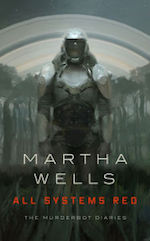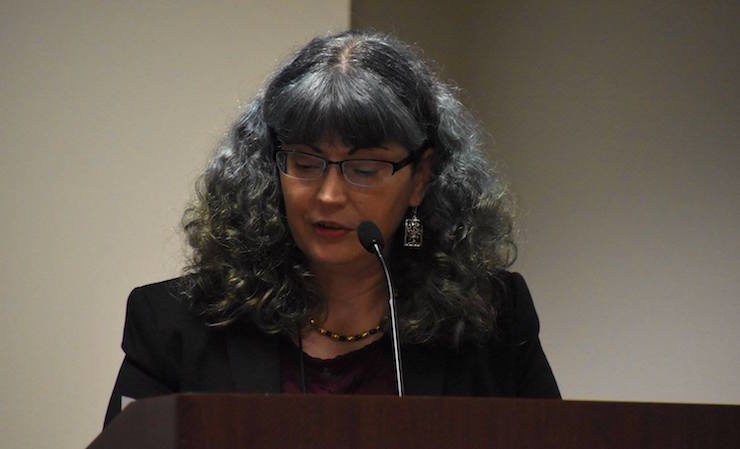The convention defines “secret history” as tales which uncover an alternative history of our world with the aid of fantasy literary devices. Like alternate histories or secret tales of the occult.
A secret history might also mean a lost history, something written in a language that died with the last native speaker. It might mean something inaccessible, written in a medium too fragile to last. Like the science fiction and fantasy stories published in U.S. newspapers in the late 1800s. We know a few of those authors, like Aurelia Hadley Mohl and Mollie Moore Davis, but how many others were there? Those stories were proof that everybody has always been here, but the paper they were printed on has turned to dust.
We might know that C.L. Moore wrote for Weird Tales, but I grew up thinking she was the only one, that a woman fantasy writer from that time period was like a unicorn, there could only be one, and that she was writing for an entirely male audience. But there were plenty of other women, around a hundred in Weird Tales alone, and many of them, like Allison V. Harding and Mary Elizabeth Counselman, didn’t bother to conceal their identity with initials.
Weird Tales had women poets, a woman editor named Dorothy McIlwraith, women readers who had their letters printed in the magazine. There were women writing for other pulps, for the earlier Dime Novels, lots of them. Including African American Pauline Hopkins, whose fantasy adventure novel appeared in a magazine in 1903.
These women were there, they existed. Everybody knew that, up until somehow they didn’t. We know there were LGBT and non-binary pulp writers, too, but their identities are hidden by time and the protective anonymity of pseudonyms.
Secrets are about suppression, and history is often suppressed by violence, obscured by cultural appropriation, or deliberately destroyed or altered by colonization, in a lingering kind of cultural gaslighting. Wikipedia defines “secret history” as a revisionist interpretation of either fictional or real history which is claimed to have been deliberately suppressed, forgotten, or ignored by established scholars.
That’s what I think of when I hear the words “secret histories.” Histories kept intentionally secret and histories that were quietly allowed to fade away.
The women writers, directors, and producers of early Hollywood were deliberately erased from movie history. Fifty percent of movies between 1911 and 1928 were written by women. In the 1940s there were a last few survivors at MGM, but their scripts were uncredited and they were strongly encouraged to conceal what they were working on, and not to correct the assumption that they were secretaries.
With the internet, it shouldn’t be possible for that to happen again. But we hear an echo of it every time someone on Reddit says “women just don’t write epic fantasy.”
You do the work, and you try to forget that there are people wishing you out of existence. But there are a lot of means of suppression that are more effective than wishing.
Like in 1974 when Andre Norton discovered the copyeditor on her children’s novel Lavender Green Magic had changed the three black main characters to white.
Or like in 1947, when African American writer and editor Orrin C. Evans was unable to publish more issues of All-Negro Comics because there was mysteriously no newsprint available for him to purchase.
Or like all the comics suppressed by the Comics Code Authority in 1954, which acted to effectively purge comics of people of color and of angry violent women, whether they were heroes or villains, or of any perceived challenge to the establishment. Like the publisher Entertaining Comics, which was targeted and eventually driven out of business for refusing to change a story to make a black astronaut white.
There’s an echo of that suppression when DC bans a storyline where Batwoman proposes marriage to her girlfriend. And again when Marvel publishes a storyline that makes us think Captain America is a Nazi. When we’re supposed to forget that his co-creator Jack Kirby was Jewish, that he was an Army scout in World War II, that he discovered a concentration camp, that he was personally threatened by three Nazis at the New York Marvel office for creating a character to punch Hitler. (Maybe the Nazis would like to forget that when Kirby rushed downstairs to confront them, they ran away.)
There’s been an active level of suppression in movies since movies were invented. At least a white woman writer and director like Frances Marion could win two Academy Awards before she was banished from history, but that wasn’t the case for her contemporary Oscar Micheaux. An African American, Micheaux worked as a railway porter before he wrote, directed, and produced at least 40 films in the black movie industry that was entirely separate from white Hollywood.
That kind of suppression is still alive and well, and we see it when the movie about the Stonewall riots shows the resistance against police attacks through the viewpoint of young white guys and ignores Marsha P. Johnson and Sylvia Rivera. Or when Ghost in the Shell features a white actress instead of Japanese.
We’ve forgotten Sessue Hayakawa, a Japanese actor who was one of the biggest stars in the silent film era of Hollywood, who was well known as a broodingly handsome heartthrob.
Sometimes history isn’t suppressed, sometimes it just drifts away. The people who lived it never expected it to be forgotten, never expected their reality to dissolve under the weight of ignorance and disbelief.
Hidden Figures by Margot Lee Shetterly unburied the history of the African American women of early NASA, of Katharine Johnson, Mary Jackson, Dorothy Vaughn and the hundreds like them. They were just forgotten over the years, as the brief time when women’s work meant calculating launch and landing trajectories and programming computers passed out of memory. Like the Mercury 13, the “Fellow Lady Astronaut Trainees” in the 1960s, all pilots, all subjected to the same tests as the men. They retired, they went away, everyone forgot them.
Sometimes when they’re remembered, their contributions are minimized, like when a photo caption calls bacteriologist Dr. Ruby Hirose a “Japanese girl scientist” or labels Bertha Pallan, who was one of the first Native American women archeologists, as an “expedition secretary.” Like the photo post on Tumblr that over and over again, identified Marie Curie as a “female laboratory assistant.” Anybody can be disappeared.
We think we remember them, but then we’re told over and over again, all over the internet, that women don’t like math, can’t do science. That’s the internet that’s supposed to preserve our history, telling us we don’t exist.
Mary Jane Seacole was a Jamaican nurse who helped the wounded on the battlefields of the Crimean War, just like Florence Nightingale. Sister Rosetta Tharpe was the mother of rock and roll. Sophia Duleep Singh was a prominent suffragette in the UK. They’re all in Wikipedia, but you can’t look them up unless you remember their names.
The women who worked in the Gibson Guitar factory during WWII were deliberately erased, their existence strenuously denied, despite the evidence of a forgotten group photo that the company still would like to claim never existed.
Jackie Mitchell, seventeen years old, struck out Babe Ruth and Lou Gehrig in an exhibition game in 1931. Her contract was almost immediately voided by the baseball commissioner. Baseball was surely too strenuous for her.
In 1994, Gregory Corso was asked, “Where are the women of the Beat Generation?” He said, “There were women, they were there, I knew them, their families put them in institutions, they were given electric shock.” Some of them survived, like Diane di Prima, and Hettie Jones.
Book burning draws too much attention. In science fiction and fantasy, in comics, in media fandom, everybody was always here, but we have been disappeared over and over again. We stumble on ourselves in old books and magazines and fanzines, fading print, grainy black and white photos, 16 millimeter film, archives of abandoned GeoCities web sites. We remember again that we were here, they were here, I saw them, I knew them.
We have to unearth that buried history. Like Rejected Princesses, by Jason Porath, which chronicles the women of history too awesome, offbeat, or awful to be animated. Or Nisi Shawl’s series the Expanded Course in the History of Black Science Fiction. Or Malinda Lo’s LGBTQ YA By the Numbers posts. Or Medieval POC, sharing information about people of color in European art history. Like Eric Leif Davin in his book Partners in Wonder: Women and the Birth of Science Fiction. Like Cari Beauchamps’ book Without Lying Down, about the women writers, directors, and producers of early Hollywood. Like Catherine Lundoff’s series on the history of LGBT Science Fiction and Fantasy. Like Saladin Ahmed’s articles on the early history of comics or Jaime Lee Moyer’s article on the erasure of early women scientists. Like all the librarians and researchers and writers and archivists and fans who work to unbury our past so we have a chance to find our future.
And we have to continue to move forward toward that future in the fantasy genre, like the nominees on this year’s World Fantasy Award ballot, like all the other fantasy novels and short fiction last year that pushed the envelope a little further, or pushed it as far as it would go.
We have to break the barriers again and again, as many times as it takes, until the barriers are no more, and we can see the future our secret history promised us.
Author’s note: I’d like to thank Kate Elliott for reading an early draft of this, and for her help, inspiration, and encouragement.
Editor’s note: Martha Wells’ toastmaster speech was delivered at the World Fantasy Convention on November 5, 2017 and is reproduced here with the author’s permission; a few minor edits have been made and links have been added to the original text for additional context/clarity.
 Martha Wells is a science fiction and fantasy writer, whose first novel was published in 1993. Her most recent series are The Books of the Raksura, for NightShade Books, and The Murderbot Diaries for Tor.com. Besides many fantasy novels, she has also written short stories, media tie-ins for Star Wars and Stargate Atlantis, YA fantasies, and non-fiction.
Martha Wells is a science fiction and fantasy writer, whose first novel was published in 1993. Her most recent series are The Books of the Raksura, for NightShade Books, and The Murderbot Diaries for Tor.com. Besides many fantasy novels, she has also written short stories, media tie-ins for Star Wars and Stargate Atlantis, YA fantasies, and non-fiction.










